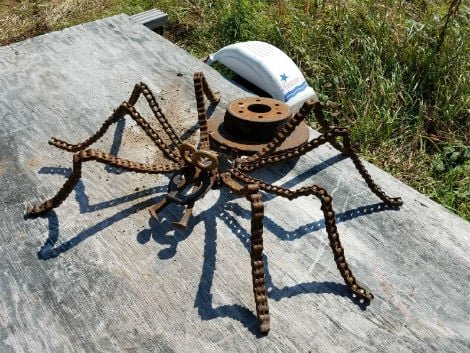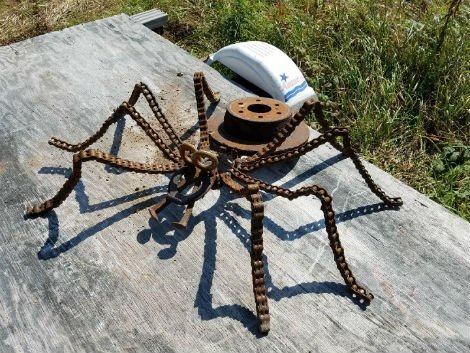 |
| Aluminum oxide contamination is no big deal for that rusty yard art project, but can wreak havoc on critical applications like an axle shaft. (Spider by John Lucas, Jr.) |
I’ve talked about weld contaminants in a previous post, but a recent conversation convinced me that it was a topic that warranted revisiting.
Aluminum oxide (AlO), in particular, is a nasty contaminant that is oft overlooked.
What exactly is AlO? Quite simply, it’s one of the most common abrasives used. It is present in most sandpaper, grinding disks, cutoff wheels, and even your favorite abrasive pads.
Why use AlO, and why is it so common? That, as well, is simple. It’s cheap, and it works. It’s a fantastic abrasive with low heat retention, making it ideally suited for all kinds of grinding processes.
Why is AlO a problem for welding? Ask a dozen welders, and you’ll get a dozen answers to this one.
Ultimately, the extent of the problem will be based on your part characteristics. If you’re welding up some rusty yard art with a stick welder, you’re probably not going to care that you just cut that shovel head and leaf spring with an AlO cutoff wheel. The residual contaminants from the parent material are going to contaminate the weld far more than the few embedded AlO particles.
Now, on the other hand, that alloy steel dragster axle shaft you’re about to have electron beam welded is going to care a whole lot about even the smallest defect. You might think that a couple of seemingly inconsequential grains of AlO abrasive couldn’t possible make the difference between a mid 5 second run and hitting the wall at breakneck speeds. That would be a dangerous assumption.
AlO melts at nearly 4,000 degrees (F), while steel melts at under 3,000 degrees (F). That means that those particles have the potential to sit buried in the resolidified weld as brittle little points of failure. No amount of post-weld heat treatment will reduce how brittle they are.
Now, let’s assume that we DO get the weld hot enough to melt the AlO particles. That should be OK, right? Not really. AlO is, as implied in the title, Aluminum and Oxygen, both of which will be liberated with sufficient heat. Neither of which you want in your steel.
As welders, we take extreme care to prevent the introduction of oxygen into our weldments. There are entire classes dedicated to this. For this blog, let’s just say oxygen is bad, mmm kay?
Aluminum is also something not desirable in steel. It forms brittle intermetallics that may or may not show up as weld defects. They WILL present in the form of unexpected strength and toughness characteristics.
One other way AlO can get you is by evaporating, but not dissolving into the parent material, causing porosity. Again, for your steel garden statue, no problem. For that axle, the results could be anywhere from embarrassing to straight-up dangerous.
What is the alternative? There are lots, but if abrasives are in your plan, consider Silicon Carbide as your final abrasive.
For more details, reach out to an expert to go over some great options for your next artistic or high speed venture. You can also leave a question or comment in the space below.

